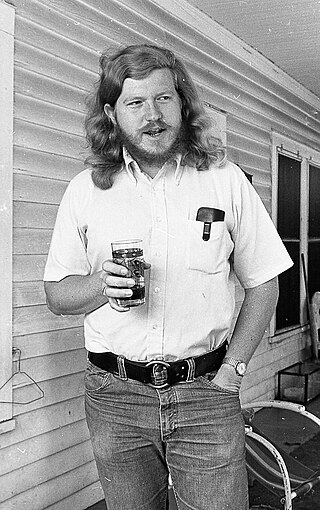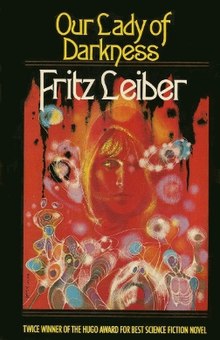
Fritz Reuter Leiber Jr. was an American writer of fantasy, horror, and science fiction. With writers such as Robert E. Howard and Michael Moorcock, Leiber is one of the fathers of sword and sorcery.

Sword and sorcery (S&S), or heroic fantasy, is a subgenre of fantasy characterized by sword-wielding heroes engaged in exciting and violent adventures. Elements of romance, magic, and the supernatural are also often present. Unlike works of high fantasy, the tales, though dramatic, focus on personal battles rather than world-endangering matters. The genre originated from the early-1930s works of Robert E. Howard. While there is a chance example from 1953, Fritz Leiber re-coined the term "sword and sorcery" in the 6 April 1961 issue of the fantasy fanzine Ancalagon, to describe Howard and the stories that were influenced by his works. In parallel with "sword and sorcery", the term "heroic fantasy" is used, although it is a more loosely defined genre.

Weird fiction is a subgenre of speculative fiction originating in the late 19th and early 20th centuries. Weird fiction either eschews or radically reinterprets traditional antagonists of supernatural horror fiction, such as ghosts, vampires, and werewolves. Writers on the subject of weird fiction, such as China Miéville, sometimes use "the tentacle" to represent this type of writing. The tentacle is a limb-type absent from most of the monsters of European gothic fiction, but often attached to the monstrous creatures created by weird fiction writers, such as William Hope Hodgson, M. R. James, Clark Ashton Smith, and H. P. Lovecraft.

Karl Edward Wagner was an American writer, poet, editor, and publisher of horror, science fiction, and heroic fantasy, who was born in Knoxville, Tennessee and originally trained as a psychiatrist. He wrote numerous dark fantasy and horror stories. As an editor, he created a three-volume set of Robert E. Howard's Conan the Barbarian fiction restored to its original form as written, and edited the long-running and genre-defining The Year's Best Horror Stories series for DAW Books. His Carcosa publishing company issued four volumes of the best stories by some of the major authors of the so-called Golden Age pulp magazines. He is possibly best known for his creation of a series of stories featuring the character Kane, the Mystic Swordsman.

Unknown was an American pulp fantasy fiction magazine, published from 1939 to 1943 by Street & Smith, and edited by John W. Campbell. Unknown was a companion to Street & Smith's science fiction pulp, Astounding Science Fiction, which was also edited by Campbell at the time; many authors and illustrators contributed to both magazines. The leading fantasy magazine in the 1930s was Weird Tales, which focused on shock and horror. Campbell wanted to publish a fantasy magazine with more finesse and humor than Weird Tales, and put his plans into action when Eric Frank Russell sent him the manuscript of his novel Sinister Barrier, about aliens who own the human race. Unknown's first issue appeared in March 1939; in addition to Sinister Barrier, it included H. L. Gold's "Trouble With Water", a humorous fantasy about a New Yorker who meets a water gnome. Gold's story was the first of many in Unknown to combine commonplace reality with the fantastic.

Dark fantasy is a subgenre of fantasy literary, artistic, and cinematic works that incorporates disturbing and frightening themes. The term is ambiguously used to describe stories that combine horror elements with one or other of the standard formulas of fantasy.
Radell Faraday Nelson was an American science fiction author and cartoonist most notable for his 1963 short story "Eight O'Clock in the Morning", which was later used by John Carpenter as the basis for his 1988 film They Live.
Donald M. Grant, Publisher, Inc. is a fantasy and science fiction small press publisher in New Hampshire that was founded in 1964. It is notable for publishing fantasy and horror novels with lavish illustrations, most notably Stephen King's The Dark Tower series and the King/Peter Straub novel The Talisman.

"The Haunter of the Dark" is a horror short story by American author H. P. Lovecraft, written between 5–9 November 1935 and published in the December 1936 edition of Weird Tales. It was the last written of the author's known stories and is part of the Cthulhu Mythos. The epigraph to the story is the second stanza of Lovecraft's 1917 poem "Nemesis".
Whispers was one of the new horror and fantasy fiction magazines of the 1970s.
Balanos Georgios (1944–2020) was a Greek translator, author, publisher and researcher of the fields of science fiction, paranormal and magick.

The Whisperer in Darkness is a 26,000-word novella by American writer H. P. Lovecraft. Written February–September 1930, it was first published in Weird Tales, August 1931. Similar to The Colour Out of Space (1927), it is a blend of horror and science fiction. Although it makes numerous references to the Cthulhu Mythos, the story is not a central part of the mythos, but reflects a shift in Lovecraft's writing at this time towards science fiction. The story also introduces the Mi-Go, an extraterrestrial race of fungoid creatures.

Spirits, Stars, and Spells: The Profits and Perils of Magic is a 1966 history book by L. Sprague de Camp and Catherine Crook de Camp, published by Canaveral Press. The book sold slowly, and the remaining stock was taken over by Owlswick Press and sold under its own name with new dust jackets in 1980. It has been translated into Polish.
Heather Gladney is an American author whose fantasy novels include Teot's War (1987) and its sequel Bloodstorm (1989).
Michael Raymond Donald Ashley is a British bibliographer, author and editor of science fiction, mystery, and fantasy.

Heroes and Horrors is a collection of fantasy and horror short stories by American writer Fritz Leiber, edited by Stuart David Schiff and illustrated by Tim Kirk. It was first published in hardcover in December 1978 by Whispers Press, and in paperback in August 1980 by Pocket Books. The paperback edition omits the illustrations.

The Second Book of Fritz Leiber is a collection of short stories and articles by American writer Fritz Leiber. It was first published in paperback in January 1975 by DAW Books. It was later gathered together with The Book of Fritz Leiber into the hardcover omnibus collection The Book of Fritz Leiber, Volume I & II.

This is a bibliography of works by Fritz Leiber.

The Hotel Union, formerly the Rhodema Hotel and the San Carlos Hotel, at 811 Geary Street in the Tenderloin neighborhood of San Francisco, California.
"Belsen Express" is a 1975 horror fiction short story, by Fritz Leiber. It first appeared in his collection The Second Book of Fritz Leiber.












